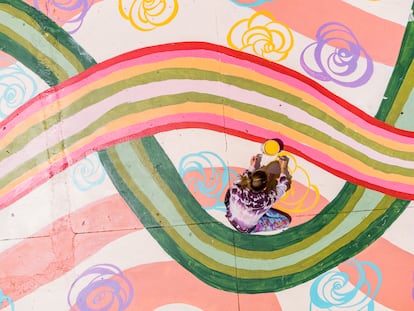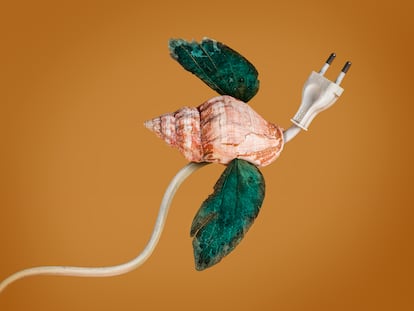DMN, the neural network at the center of human creativity: ‘Without it, we wouldn’t have any ideas’
This default mode is activated during divergent thinking, and researchers believe it plays a key role in our flashes of genius

It is a never-ending stream. A constant drip of ideas, memories, projections and images that flows freely, independent of our will to perform cognitive tasks. Conceptualized in 2001 by Marcus E. Raichle, the default mode network (DMN) is an empirical endorsement of the stream of consciousness James Joyce embraced in his book Ulysses. And like the Irish author’s novel, the DMN — or its unstoppable flow — often appears disjointed and chaotic. According to several studies published in recent years, the DMN also hides a wellspring from which, at times, genius springs forth. It may indeed be the nerve center of human creativity.
The most recent study on NDR and creative thinking was published last June in Brain, the neurology journal from Oxford University Press. Ben Shofty, a neurosurgeon and professor at the University of Utah, placed electrodes on 13 epileptic patients at certain points in the brain where this network extends. His intention was not to stimulate these areas, but to inhibit them. “We don’t know how to make the brain work better, but we can, by applying electric currents, artificially turn off certain areas,” Shofty explains via video conference. With DMN inhibited, he asked the participants to find divergent uses for everyday objects, the standard test for measuring creativity. The originality of the answers dropped considerably compared to a normal situation, “when the brain is not altered,” he continues.
By 2022, Shofty had already published another study in Nature that backed these findings. He claims that his work “has established direct causality and not a mere correlation between DMN and creativity.” Before Shofty decided to place electrodes on his patients, other researchers had found — using functional magnetic resonance imaging (fMRI) — a clear association between this network and the ability to invent new uses for a shoe or a paper clip. “My main advantage is that I can manipulate the brain. Most people investigate brain functions with correlative methods: they set up the fMRI, ask people to do a task, and certain areas light up.” It had already been amply shown that activating DMN encourages people to think beyond the obvious. Now, we also know that, when it is inhibited, our potential for divergent thinking falters too.
The link between DMN and divergent thinking also appears to be a question of size. In 2013, Simone M. Ritter and others found that individuals with more gray matter in the brain areas corresponding to this network were better at coming up with alternative uses for common objects. Since then, Ritter has been doing extensive research into the circumstances that best foster creativity. She combines her academic work at Radboud University in the Netherlands with consulting jobs for companies. She combines a social perspective with an emphasis on the DMN of each individual, which she stimulates through innovative techniques: “We use, for example, virtual reality to make the subject progress through different stages until they reach a DMN state,” she explains.
A milestone in this neuroscientific field came in 2018, when Roger Beaty discovered — thanks to research published in PNAS — that creative ideas emerge when there is communication between the DMN and two other brain networks: the salience network (which assesses the importance of internal or external stimuli) and the executive network (which allows us to focus on a specific cognitive task).
“There is a relationship between the degree of connectivity between these three networks and the extent to which people are able to cognitively diverge,” explains Beaty, who today coordinates a laboratory on creativity and neuroscience at Penn State University. While there are no certainties, Beaty explains what he believes happens in the brain when a person has a flash of creativity. “The DMN would generate the idea; the salience network would ignore it or not; and, if it passes the filter, the executive network would elaborate it.”
Shofty does not question Beaty’s findings. In fact, the two researchers have begun to collaborate in order to dissect, to the millisecond, a process that “occurs at enormous speed,” explains Beaty.
Shofty has no doubt that the DMN is at the origin of everything. “It produces a continuous flow that, at times, synchronizes with the other two networks.” Beaty, for his part, prefers to wait for new research to confirm the hypothesis that DMN is at the epicenter of creativity. In principle, he considers it very probable. Although, he clarifies, “there could be cases in which this is not the case or forward-backward dynamics that have not yet been detected.”
Beaty says that some studies have shown that patients with lesions in the DMN have “great difficulties” when it comes to imagination, which “is closely related to memory, which we use to find something new.” And, despite being caution, he is adamant that DMN plays a key role, whether it is to helps us dream about our next trip or outline an astrophysical theory that will win us a Nobel Prize: “Without it, we probably wouldn’t have any ideas.”
Shofty points to a curious phenomenon — detected in a 2023 study — that reveals our brain’s potential to redirect possible adversities. This research also highlighted the complexity of analyzing a concept as polymorphic and subjective as creativity. It turns out that many people suffering from frontotemporal dementia tend to develop an overwhelming need for artistic expression: “They paint a lot, some obsessively.” Dementia, explains Shofty, “causes the connections between the frontal and temporal lobes, which are the main nodes in the DMN, to disintegrate.” With the flow of consciousness inhibited, Shofty continues, “creativity moves to the posterior, more visual parts of the brain; it is like a balance: one area is turned off and the other is overactivated.”
Losing focus
Some researchers are cautious about giving DMN such a prominent role, especially since studies on the topic rely on a limited measurement technique and tend to focus on a rather narrow notion of creativity. “I’m inclined to think that Beaty and Shofty are right, but it would seem presumptuous to build an entire theory of creativity on an experiment that is in itself somewhat strange: people don’t go around thinking about what they could do with a brick other than build buildings,” says John Kounios, professor of brain sciences at Drexel University and co-author of The Eureka Factor. This book focuses on moments of cognitive revelation in which a problem suddenly seems to be solved. Or in which, at least, a possible solution occurs to us that is worth exploring.
Kounios breaks down the details of the eureka moment. When it occurs, there is a “sudden burst of high-frequency brain waves” that is preceded by a blackout in the visual cortex: “For a fraction of a second, you don’t see very well because your brain filters out distracting elements.” What’s more, the emergence of a (seemingly) great idea is followed by “an activation of the reward system, the same one that is activated when you eat something delicious, have an orgasm or take drugs.” Ideas that are viable in principle spark a rush of dopamine. “That’s why some people get hooked on composing songs or writing poetry, even if it doesn’t make them much money,” says Kounios, smiling.
In his latest study, published last March, Kounios focuses on the “creative flow” of jazz musicians during improvisations. This occurs, the study concludes, when previously acquired mastery and the ability to let go converge. Kounios describes creative flow as a kind of advanced stage in the connection between neural networks— DMN, salience and executive — coined by Beaty. “With a lot of experience in a particular action, for example playing jazz, perhaps that connectivity is no longer necessary because a new network would develop in which creativity simply flows.”
If, despite the doubts still looming over the essence of creativity, we accept the importance of DMN in generating novel ideas, the experts have some advice on how to reach a state of flow. “Sometimes you have to lose focus to be more creative, even though it sounds counterintuitive,” says Ritter. To do this, it helps to exercise, walk in nature or meditate. “Anything that lets our mind wander, because that’s when the best ideas come,” suggests Shofty.
Sign up for our weekly newsletter to get more English-language news coverage from EL PAÍS USA Edition
Tu suscripción se está usando en otro dispositivo
¿Quieres añadir otro usuario a tu suscripción?
Si continúas leyendo en este dispositivo, no se podrá leer en el otro.
FlechaTu suscripción se está usando en otro dispositivo y solo puedes acceder a EL PAÍS desde un dispositivo a la vez.
Si quieres compartir tu cuenta, cambia tu suscripción a la modalidad Premium, así podrás añadir otro usuario. Cada uno accederá con su propia cuenta de email, lo que os permitirá personalizar vuestra experiencia en EL PAÍS.
¿Tienes una suscripción de empresa? Accede aquí para contratar más cuentas.
En el caso de no saber quién está usando tu cuenta, te recomendamos cambiar tu contraseña aquí.
Si decides continuar compartiendo tu cuenta, este mensaje se mostrará en tu dispositivo y en el de la otra persona que está usando tu cuenta de forma indefinida, afectando a tu experiencia de lectura. Puedes consultar aquí los términos y condiciones de la suscripción digital.
More information
Archived In
Últimas noticias
NASA discovers Titan doesn’t have an ocean, but a ‘slushy ice layer’ that increases possibility of life
Innocence lost in the forest of the child soldiers: ‘Each leader of the armed group had his girls’
‘Fallout’ or how the world’s largest company turned an anti-capitalist apocalyptic Western into a phenomenon
From inflation to defending migrants: Eileen Higgins and Zohran Mamdani inaugurate the new Democratic resistance against Trump
Most viewed
- ‘El Limones’ and the growing union disguise of Mexican organized crime
- Christian Louboutin: ‘Young people don’t want to be like their parents. And if their parents wear sneakers, they’re going to look for something else’
- The low-cost creative revolution: How technology is making art accessible to everyone
- ‘We are dying’: Cuba sinks into a health crisis amid medicine shortages and misdiagnosis
- A mountaineer, accused of manslaughter for the death of his partner during a climb: He silenced his phone and refused a helicopter rescue










































